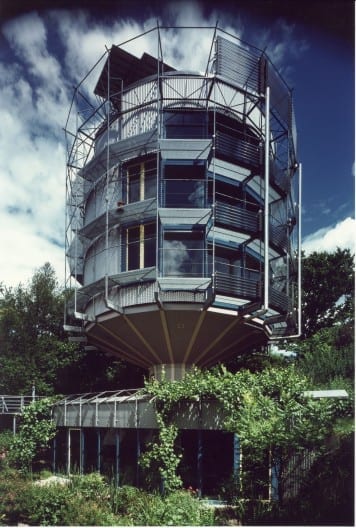
If someone asks you to describe a solar power plant you’d likely look to convey an image of row upon row of sun-soaking panels pointing skyward.
It’s doubtful that the first thought to pop into your head would be of someone’s home, unless of course you’ve already witnessed the likes of the Heliotrope. Sited at the foot of the Black Forest in Germany, this magnificent cylindrical power house is the creation of solar architect Rolf Disch and is the world’s first home to produce more energy than it consumes. As the architect announces plans to take his PlusEnergy vision to a global audience, we take a closer look at his first creation.
Towering above the homes and vineyards that surround it stands the Heliotrope home of solar architect Rolf Disch. Whilst a few of the other buildings in the southern German city of Freiburg sport the odd rooftop solar panel to offset some of the spiraling energy costs, using freely available energy from the sun is central to the very design of the Heliotrope. And just like the flora that inspired its name, this solar tower actually follows the path of the sun as it makes its way across the sky.
The main structure of the house is built onto a central load-bearing wooden column that’s 47.5 feet (14.5m) high and has a diameter of 9.5 feet (2.9m). The house is designed to rotate around the column at a rate of about 15 degrees per hour, following the path of the sun. It regulates heat entering the home by facing its triple-glazed windows in the sun’s direction in winter and pointing its insulated rear sunward during the warmer summer months. Inspection balconies outside also incorporate sunshades to help prevent seasonal overheating.
Snaking around the balconies are special railings that double up as solar thermal tube collectors and provide hot water for the building’s domestic needs and supply storage tanks for space heating. As heat from the sun pours through the Heliotrope’s windows, it is stored and used by the floor heating system and a geo-thermal heat exchange system makes the most of controlled ventilated air. There’s also a low-temperature ceiling radiation system that helps keep rooms nice and toasty when needed.
On the building’s roof sits the impressive solar sail. It’s made up of highly-efficient monocrystalline silicon solar cells and is able to independently rotate on a two-axis system, allowing for both horizontal and vertical adjustment for optimum tracking. This design is said to achieve an energy gain of between 30 and 40 percent over conventional fixed-panel units.








